Ditapis dengan
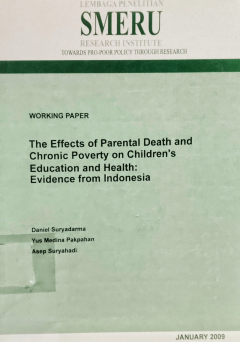
The Effects of Parental Death and Chronic Poverty on Children's Education and…
Using a sufficiently long-spanning longitudinal dataset, we estimate the short and long term effects of maternal and paternal death on children’s school enrollment, educational attainment, and health in Indonesia, then compare them to the effect of chronic poverty. We also investigate whether there are any gender dimensions in the effects.
- Edisi
- 1
- ISBN/ISSN
- -
- Deskripsi Fisik
- 16 halaman
- Judul Seri
- Textbook
- No. Panggil
- 362.5 DAN e

The Impact of Private Sector Growth on Poverty Reduction: Evidence from Indon…
This study examines the impact of private sector growth on poverty reduction in Indonesia, utilizing data spanning from 2000 to 2020. The analysis employs econometric models to investigate the relationship between private sector development and poverty alleviation, focusing on key indicators such as employment generation, income levels, and access to basic services. The findings indicate that r…
- Edisi
- Working Paper April 2007
- ISBN/ISSN
- 978-979-3872-37-7
- Deskripsi Fisik
- ii, 20 halaman ; 31 cm.
- Judul Seri
- Textbook
- No. Panggil
- 362.5 DAN i
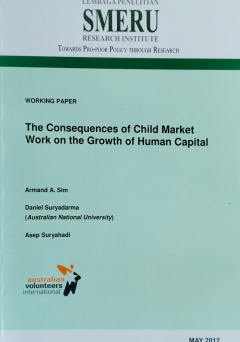
The Consequences of Child Market Work on the Growth of Human Capital
Conceptually, the effect of child labor on human capital is ambiguous. On one hand, working can displace schooling. Even in the case where working and schooling go hand-in-hand, the negative effect of working can come through reducing time available for studying, playing, and sleeping.
- Edisi
- 1
- ISBN/ISSN
- -
- Deskripsi Fisik
- 25 halaman
- Judul Seri
- Textbook
- No. Panggil
- 362.5 ARM c
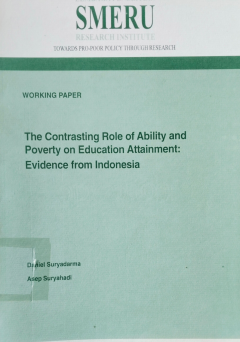
The Contrasting Role of Ability and Poverty on Education Attainment: Evidence…
This study measures the relative role of poverty and scholastic ability on education attainment in developing countries, where a substantial portion of the population still live in poverty and poor people are markedly credit constrained. Different from most studies in developing countries, this paper uses a multiple-wave and long-spanning panel dataset that follows a cohort of children beginnin…
- Edisi
- 1
- ISBN/ISSN
- -
- Deskripsi Fisik
- 20 halaman
- Judul Seri
- Textbook
- No. Panggil
- 362.5 DAN d
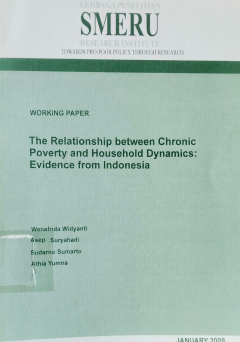
The Relationship between Chronic Poverty and Household Dynamics: Evidence fro…
The composition of households frequently change due to births, deaths, divorces, marriages, the departure of children from home, and other compositional changes. Consequently, a large number of people undergo some fundamental change in household arrangements during relatively short periods of time.
- Edisi
- 1
- ISBN/ISSN
- -
- Deskripsi Fisik
- 18 halaman
- Judul Seri
- Textbook
- No. Panggil
- 362.5 WEN r
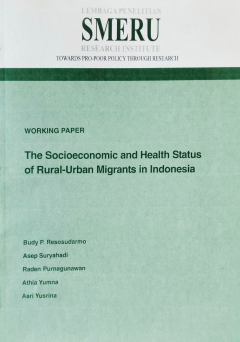
The Socioeconomic and Health Status of Rural-Urban Migrants in Indonesia
The movement of people from rural to urban areas, popularly known as urbanization, is a common phenomenon observed all over the world during a country’s process of development. The Harris-Todaro model has long been used to explain this phenomenon. In general, the prevalence of higher average incomes in urban areas has attracted large numbers of rural people to move to urban areas (Harris and …
- Edisi
- 1
- ISBN/ISSN
- -
- Deskripsi Fisik
- 15 halaman
- Judul Seri
- Textbook
- No. Panggil
- 362.5 BUD s
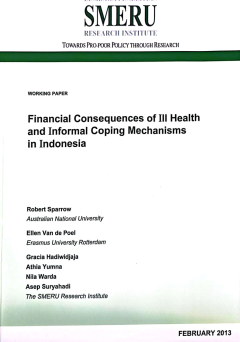
Financial Consequences of Ill Health and Informal Coping Mechanisms in Indonesia
We assess the financial risk of ill health for households in Indonesia, the role of informal coping strategies, and the effectiveness of these strategies in smoothing consumption. Based on household panel data, we find evidence of financial risk from illness through medical expenses, while income from informal wage labor is exposed to risk for the poor and income from self-employed business act…
- Edisi
- 1
- ISBN/ISSN
- 9789793872988
- Deskripsi Fisik
- i, 16 hal. ; 30 cm.
- Judul Seri
- Textbook
- No. Panggil
- 332 SPA f
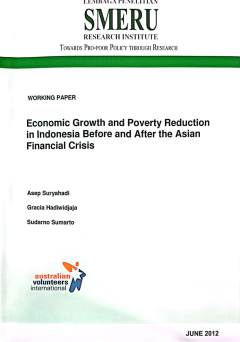
Economic Growth and Poverty Reduction in Indonesia Before and After the Asian…
This paper assesses the relationship between economic growth and poverty reduction in Indonesia before and after the Asian financial crisis (AFC). Indonesia has a significantly slower poverty reduction post-AFC compared to the pre-AFC era. The trend in the growth elasticity of poverty indicates that the power of each% of economic growth to reduce poverty did not change greatly between the p…
- Edisi
- 1
- ISBN/ISSN
- 9789793872964
- Deskripsi Fisik
- iii, 20 hal. ; 30 cm.
- Judul Seri
- Textbook
- No. Panggil
- 362.5 ASE e

Accelerating Poverty and Vulnerability Reduction: Trends, Opportunities, and …
Despite progress in poverty reduction during the last four decades, Indonesia is still plagued by a high rate of multidimensional poverty and deprivation. The 2009 monetary poverty rate of 14.15% is 5.95 percentage points higher than the government’s initial target, while, in other dimensions of poverty, Indonesia lags behind its neighbors. There are opportunities for accelerating poverty red…
- Edisi
- May 2012
- ISBN/ISSN
- 978-979-3872-94-0
- Deskripsi Fisik
- iii, 18 halaman
- Judul Seri
- Textbook
- No. Panggil
- 365.2 SME a

Assessment of Policies to Improve Teacher Quality and Reduce Teacher Absenteeism
To avoid the middle income trap, Indonesia needs to start shifting its economy to highervalue products, which requires a workforce that has an increasingly high level of knowledge, skills, and competencies. This implies that Indonesia needs to put more serious effort into the improvement of the quality of its education system. Currently only 37% of teachers have the appropriate teaching qualifi…
- Edisi
- Working Paper
- ISBN/ISSN
- 978-602-7901-09-4
- Deskripsi Fisik
- iii, 19 halaman
- Judul Seri
- Towards Pro-Poor Policy Through Research
- No. Panggil
- 379.1 SME a
 Karya Umum
Karya Umum  Filsafat
Filsafat  Agama
Agama  Ilmu-ilmu Sosial
Ilmu-ilmu Sosial  Bahasa
Bahasa  Ilmu-ilmu Murni
Ilmu-ilmu Murni  Ilmu-ilmu Terapan
Ilmu-ilmu Terapan  Kesenian, Hiburan, dan Olahraga
Kesenian, Hiburan, dan Olahraga  Kesusastraan
Kesusastraan  Geografi dan Sejarah
Geografi dan Sejarah